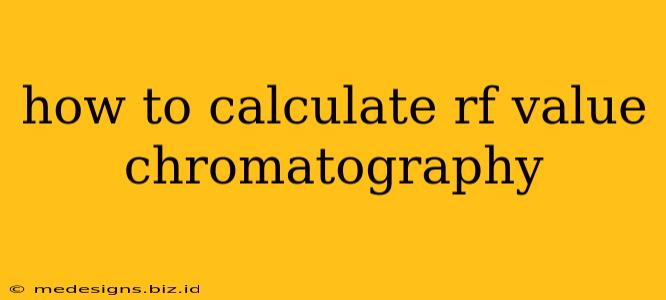Chromatography is a powerful laboratory technique used to separate mixtures into their individual components. A crucial part of analyzing chromatography results involves calculating the retention factor (Rf) value. This guide will walk you through the process, explaining what Rf is, why it's important, and how to calculate it accurately.
Understanding the Retention Factor (Rf)
The Rf value is a dimensionless number that represents the ratio of the distance traveled by a specific compound to the distance traveled by the solvent front in a chromatography experiment. It's a valuable tool because it helps identify unknown compounds by comparing their Rf values to known standards. A compound's Rf value will remain relatively consistent under the same experimental conditions (solvent system, stationary phase, temperature).
Key elements in calculating Rf:
- Solvent Front: The furthest point reached by the solvent on the chromatography paper or plate.
- Compound Spot: The distance the center of the compound's spot traveled from the origin.
- Origin: The initial point where the sample was applied.
How to Calculate Rf Value: A Step-by-Step Guide
Calculating the Rf value is straightforward:
1. Measure the Distance Traveled by the Solvent Front: Use a ruler to carefully measure the distance from the origin (where you spotted your sample) to the furthest point reached by the solvent. This distance is denoted as distance of solvent front (Ds).
2. Measure the Distance Traveled by the Compound: Measure the distance from the origin to the center of the compound's spot. This is the distance of the compound (Dc).
3. Calculate the Rf Value: Use the following formula:
Rf = Dc / Ds
Example:
Let's say the solvent front traveled 8 cm (Ds = 8 cm), and your compound traveled 5 cm (Dc = 5 cm). The Rf value would be:
Rf = 5 cm / 8 cm = 0.625
Important Considerations:
- Units: The units (cm, mm, etc.) cancel out in the calculation, making Rf a dimensionless number.
- Accuracy: Use a sharp pencil and ruler for precise measurements. Errors in measurement directly affect the Rf value.
- Consistency: Keep experimental conditions consistent to obtain reproducible Rf values. Slight variations in temperature, solvent composition, or stationary phase can alter Rf values.
- Rf Range: Rf values typically range from 0 to 1. A value of 0 indicates the compound did not move from the origin, while a value of 1 indicates the compound moved with the solvent front.
Why is Rf Value Important?
The Rf value provides crucial information in chromatography:
- Compound Identification: By comparing the calculated Rf value to known values for different compounds under the same chromatographic conditions, you can tentatively identify the components in your mixture. Databases of Rf values exist for various compounds and solvent systems.
- Monitoring Reactions: Rf values can be used to monitor the progress of chemical reactions by tracking the disappearance of reactants and appearance of products.
- Purity Assessment: If a single spot is obtained for a sample, it suggests the sample is a pure compound. If multiple spots appear, it indicates a mixture.
Optimizing your Chromatography Results for Accurate Rf Values
Several factors impact the accuracy of your Rf values:
- Solvent Selection: Choose an appropriate solvent system that provides good separation of the components in your mixture. A solvent that is too polar or too nonpolar may result in poor separation and inaccurate Rf values.
- Plate Quality: Use high-quality chromatography paper or thin-layer chromatography (TLC) plates for consistent results.
- Sample Application: Ensure the sample is applied as a small, concentrated spot at the origin to avoid tailing or streaking.
- Chamber Saturation: Allow sufficient time for the chromatography chamber to become saturated with solvent vapors before running the chromatography. This helps to create a uniform solvent front.
By carefully following these steps and paying attention to experimental conditions, you can accurately calculate Rf values and utilize this valuable tool for effective compound identification and analysis in your chromatography experiments.
